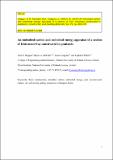| dc.contributor.author | Duggan, Alan R. | |
| dc.contributor.author | McCabe, Bryan A. | |
| dc.contributor.author | Goggins, Jamie | |
| dc.contributor.author | Clifford, Eoghan | |
| dc.date.accessioned | 2017-02-14T11:07:26Z | |
| dc.date.available | 2017-02-14T11:07:26Z | |
| dc.date.issued | 2015-01-29 | |
| dc.identifier.citation | Duggan, Alan R., McCabe, Bryan A., Goggins, Jamie, & Clifford, Eoghan. (2015). An embodied carbon and embodied energy appraisal of a section of Irish motorway constructed in peatlands. Construction and Building Materials, 79, 402-419. doi: http://dx.doi.org/10.1016/j.conbuildmat.2014.12.015 | en_IE |
| dc.identifier.issn | 1879-0526 | |
| dc.identifier.uri | http://hdl.handle.net/10379/6302 | |
| dc.description.abstract | In addition to the customary drivers of cost and timely project delivery, embodied energy (EE) and embodied carbon (EC) have come to prominence in recent years as major design considerations in all aspects of large-scale road construction projects. An assessment of road construction necessitating the excavation or alteration of peat should consider the impact on carbon stored within the peat and the greenhouse gases potentially released. A methodology for calculating the environmental impact of constructing roads on peat is presented in this paper. Furthermore, the paper describes the application of this methodology (focusing on EE and EC calculations) to a case study; a section of the M6 motorway in Ireland for which excavate-and-replace was the ground improvement method (Scenario ER). A range of peat-related factors impacting on EE and EC estimates were examined, including materials, transport and machinery, as well as more unfamiliar factors such as peat drainage, drainage systems, restoration, slope stability and clearance of vegetation/forest. Comparisons of total EC are investigated under various management practices and restoration techniques for peatlands, assessing their strength in terms of hydrology and carbon storage potential. The total EC and EE for road construction to the sub-base level (and implications thereof) of the 2.14 km section of the M6 discussed in this paper was 17,220 tCO(2)eq (8047 tCO(2)eq/km) and 54,541 GJ (25,487 Gl/km), respectively, with carbon loss from excavated peat accounting for 62% of the total EC. Two other ground improvement method scenarios for constructing this section of road were also considered: Scenario S, soil-mixing and Scenario ER + P, an appropriate combination of excavate-and-replace and piling. Scenario S gave rise to a total EC of 25,306 tCO(2)eq (11,825 tCO(2)eq/km) and a total EE of 164,364 GJ (76,806 GJ/km) while Scenario ER + P gave rise to a total EC of 17,048 tCO(2)eq (7966 tCO(2)eq/km) and a total EE of 92,706 GJ (43,320 GJ/km). In this study, Scenario ER was the preferred technique as it had EC comparable to Scenario ER + P and the lowest EE. On the other hand, Scenario S was the least favourable due to the high EC and EE of the binder. However, this paper shows that the EC and EE can be decreased dramatically by changing the binder proportions. Furthermore, the EC of Scenarios ER and ER + P can also be significantly reduced if alternative restoration techniques are employed for excavated peat. (C) 2014 Elsevier Ltd. All rights reserved. | en_IE |
| dc.description.sponsorship | The authors thank the College of Engineering and Informatics at National University of Ireland, Galway for their financial support. | en_IE |
| dc.format | application/pdf | en_IE |
| dc.language.iso | en | en_IE |
| dc.publisher | Elsevier | en_IE |
| dc.relation.ispartof | Construction And Building Materials | en |
| dc.rights | Attribution-NonCommercial-NoDerivs 3.0 Ireland | |
| dc.rights.uri | https://creativecommons.org/licenses/by-nc-nd/3.0/ie/ | |
| dc.subject | Road construction | en_IE |
| dc.subject | Embodied carbon | en_IE |
| dc.subject | Embodied energy | en_IE |
| dc.subject | Peat excavate-and-replace | en_IE |
| dc.subject | Dry soil-mixing | en_IE |
| dc.subject | Piling | en_IE |
| dc.subject | Restoration techniques | en_IE |
| dc.subject | Binder | en_IE |
| dc.subject | Civil engineering | en_IE |
| dc.subject | Blanket bog | en_IE |
| dc.subject | Peat | en_IE |
| dc.subject | Drainage | en_IE |
| dc.subject | Fluxes | en_IE |
| dc.subject | Variability | en_IE |
| dc.subject | Vegetation | en_IE |
| dc.subject | Ditches | en_IE |
| dc.subject | Methane | en_IE |
| dc.subject | Forest | en_IE |
| dc.title | An embodied carbon and embodied energy appraisal of a section of Irish motorway constructed in peatlands | en_IE |
| dc.type | Article | en_IE |
| dc.date.updated | 2017-02-13T16:30:45Z | |
| dc.identifier.doi | 10.1016/j.conbuildmat.2014.12.015 | |
| dc.local.publishedsource | http://dx.doi.org/10.1016/j.conbuildmat.2014.12.015 | en_IE |
| dc.description.peer-reviewed | peer-reviewed | |
| dc.contributor.funder | |~| | |
| dc.internal.rssid | 8622191 | |
| dc.local.contact | Bryan Mccabe, Dept. Of Civil Engineering, Coll Engineering & Informatics, Room Eng-1040, Nui Galway. 2021 Email: bryan.mccabe@nuigalway.ie | |
| dc.local.copyrightchecked | No | |
| dc.local.version | ACCEPTED | |
| nui.item.downloads | 829 | |


